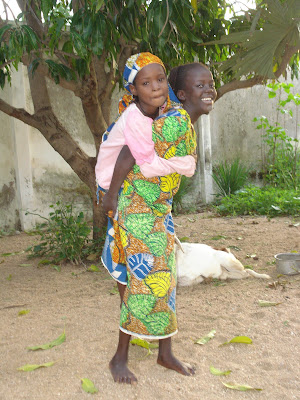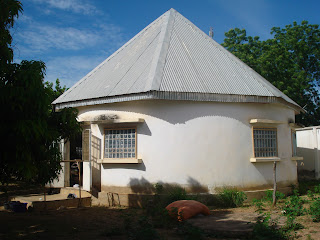In the weeks leading up to my
departure from the United States, my expectations about everyday life in
Cameroon were based on the thought that I would have the most basic and
necessary accommodations accompanied by a limited selection of dining
options. If you have low expectations, you
are not surprised with having little to nothing and every luxury above the
minimum a bonus. I had preferences, of
course, but was ultimately willing to live and work pretty much anywhere. As such, I developed a fairly standard
response to all of the questions about how much different everyday life was
going to be here in Cameroon. Gone are
the days of living alone in my two bedroom condo with wifi, two televisions and
the bonus option of choosing which shower I was going to use in the
morning. I was more than ready to trade it
all in for bucket baths, no electricity and a stack of books that I certainly
should have read by now --- such as Slaughterhouse Five, Animal Farm, and the
Age of Reason (that’s right Mom, I have not yet read these books). You know, the types of books that make
Jeopardy champions. And I had already survived
four years on a steady diet of oatmeal, peanut butter & jelly with pretzels
and a rotation of chili, spaghetti and macaroni & cheese … so how hard
could it be to adjust to a new cuisine that would certainly provide more
variety than before?
Needless to say, these low
expectations paid serious dividends when I arrived in Guider for site visit
back in July. As a result of some
unfortunate thievery from the previous volunteer’s house, a new house was found
in a large compound with a giant wall and overnight security. Its not quite what we have come to know about
the infamous compound in Abottabad, but I take comfort in knowing that any bandit
will really have to earn it if they are tempted to explore what my house has to
offer.
Another added benefit of my house
is the family that shares the compound.
What was once a polygamist Muslim family with a husband and no less than
three wives (not sure how many to be exact) is now a mélange of the close
relatives of the oldest widowed wife.
While I have yet to formally work out a family tree – I’ve barely even learned
everyone’s name due to the constant flow of friends and family – this type of
situation is nonetheless an accurate representation of how a Cameroonian family
operates. Relatives that are considered
to be part of the extended family in the United States are routinely accepted as
part of the immediate family here in Cameroon where cousins introduce each
other as brothers and/or sisters, and parents have no qualms about treating
their nieces and nephews as their own children.
With that in mind, and when remembering how quickly I was treated as
part of the family during training in Bafia, I have not been surprised at all
about their hospitality thus far. At
least once or twice per week I receive a knock on my door accompanied by a
plate of the latest kitchen creation --- most recently a mixture derived from a
pumpkin-esque melon and ground up nuts that had a consistency similar to dry
mashed potatoes. Whether it has been the
gumbo with couscous, candied peanuts, or fresh fruit picked from a tree in our
compound, everything has been quite delicious and unlike anything I’ve had
before.
 |
| A couple of the girls from the family, with the mouton in the background resting up for his big day |
As for my house, my method in
describing it to other volunteers has devolved from a point of great excitement
and pride to a feeling of slight embarrassment due to the luxuries that it affords. Not only does it have running water,
electricity and two bedrooms, but it also provides me with the opportunity to
choose which shower to use every day. So
much for my previous assumption that I would be taking bucket baths and
fetching water from a nearby well. In
addition to that, having a combination of the previous volunteer’s stuff (i.e.
cookware, furniture, etc.) and whatever the family left inside, I didn’t have
to go from one market to another in search of missing necessities. Compared to other volunteers, many of whom started
with an empty house and had to work out the complicated logistics of getting
everything back to post on motos, taxis or buses, I had it pretty easy.
 |
| My house with mango trees on the left and a guava tree around back |
After taking a tour of the big
house in the compound and seeing many of the modern amenities such as a water
heater, oven and a television, its readily apparent that this situation is
quite modern compared to what we can find less than a block away. With very few exceptions here in Cameroon, a
mud hut with a thatch roof is never far away, even in large villages and big
cities. And in my cartier (or neighborhood),
its quite common to see these modern houses interspersed with traditional
dwellings. It was quite the contrast this
past Sunday when I was searching the internet from the comfort of my couch
while looking out my door and seeing the family’s domestique washing the dishes
in a puddle of water left over from the most recent rainfall. Despite the running water and ability to do
the dishes inside, for a woman that comes from a small village and only speaks
the local language, old habits surely die hard.
 |
| Traditional homes situated amongst the cornstalks |
In the same way you don’t have to
look hard to find traditional homes amongst the modern, we are never far away
from open roads and scenic views. As is
the case for the Sahel, the name for the geographical landscape in northernmost
Cameroon, a view of the horizon is devastatingly flat in each direction set
against the backdrop of a mountain range to the west and south, and a matrix of
oddly situated two or three-peak mountains to the north and east. Its quite a sight during the rainy season, as
green is the prevailing color in all directions – hence, the number of cattle,
goats and sheep grazing this time of year – but I’m sure it will also make for
an equally spectacular scorched-earth view during the eight month dry season
between October and June.
 |
| A view of the Sahel and the mountains to the west |